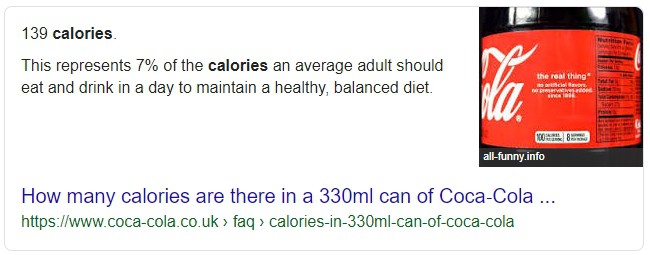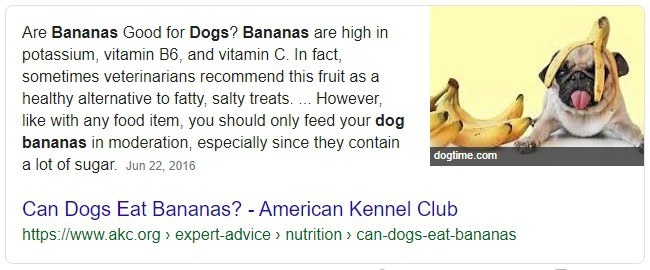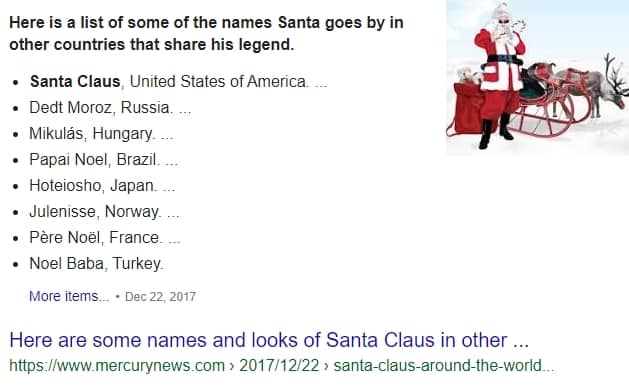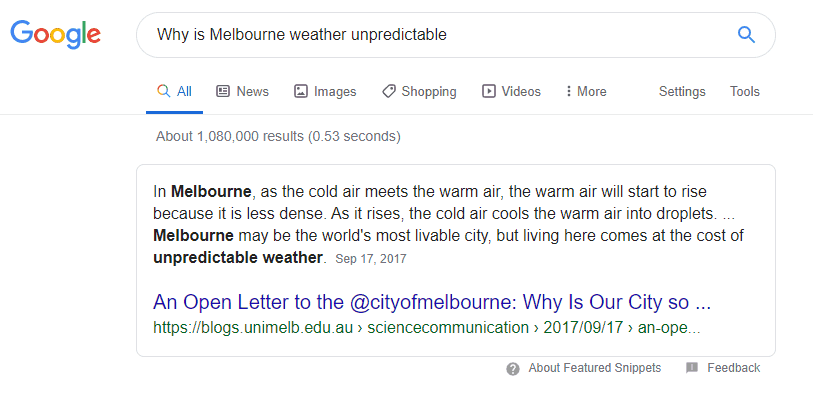Google’s main objective is to be the king of convenience. Not only with its search engine, but also with its extensive range of other applications, such as Google Calendar, Google Keep Notes, Google Drive, and more.
With its search engine, in particular, with the growing need for instant-results and instant-answers from users online, Google has always tried to answer users search queries in the fastest and most effective way possible.
So… featured snippets arrived. Featured snippets are short, simple answers that take priority over ordinary search results to users’ queries, and therefore appear at the very top of the search results.
 By asking Google simple questions – How old is Ben Stiller? How many calories are in a litre of Coke? What’s the average Australian house price? – the simple, straightforward answer, or ‘featured snippet’ will appear at the top of your search results. Depending on the questions you’re asking and the answer required, various websites have to optimise and regulate their content in order to be featured where a ‘featured snippet’ usually is.
By asking Google simple questions – How old is Ben Stiller? How many calories are in a litre of Coke? What’s the average Australian house price? – the simple, straightforward answer, or ‘featured snippet’ will appear at the top of your search results. Depending on the questions you’re asking and the answer required, various websites have to optimise and regulate their content in order to be featured where a ‘featured snippet’ usually is.
But many don’t realise how much more attention and traffic you can gain simply by appearing at the very top. With many users only paying attention to what’s at the top, being featured here can make a world of difference.
This article will go over exactly what ‘featured snippets’ are, as well as the different type of snippets, and why they’re so important for both Google users, and Googleable websites.
What Are Featured Snippets?
In short, a featured snippet is Google’s own choice of answer to your search query, and as such is displayed above all other search results.
They’re basically a block of text just below the search bar summarising the answer to your query, usually with very minimal detail. Featured snippets are simple, straightforward, and usually contain the bare minimum information in order to answer the question and nothing more.
Types of Featured Snippets
Featured snippets do vary, and there are three main types you’ll come across:
- Answers formatted as a list
- Answers formatted as a table
- Answers formatted as a paragraph
The common feature snippet users come across is a paragraph, as this gives the information to the user in the most simple, digestible way.
This type of snippets makes up over 80% of snippets appearing in Google’s search results across the globe, with lists coming in second place with just over 10%, and tables coming in third place, with less than 8%.
Featured Snippets vs. Rich Snippets
It’s important to note that ‘featured snippets’ aren’t the only type of snippets that can come up on Google. Rich snippets are quite different – these don’t always appear at the top of search engines, but can in fact appear anywhere.
Rich snippets aren’t Google’s answers to questions, but are varied versions of ‘organic results’, that have key information highlighted. This might be titles, rating, photos, prices, etc. Rich snippets are, in essence, extended versions of ordinary search results, and as such have a better click-through rate than ordinary results.
How to Get Featured
Most people assume that you have to be the very first result in order to have your snippet as a ‘featured snippet’ on Google, but this isn’t the case. In fact, most featured snippets aren’t the first result that comes up.
The most important thing needed to be featured isn’t to be in the first position, but rather on the first page, as almost all featured snippets (over 90%) come from the first page of search results.
Here are our tips to bear in mind when hoping to get featured:
1. Answer Questions Directly
 The whole point of a featured snippet is that it’s short, simple and concise – and therefore for your answer to be featured, you’ll have to do the same. Google favours content that answers the query in as few words as possible; the average length of featured paragraphs is around 50-100 words.
The whole point of a featured snippet is that it’s short, simple and concise – and therefore for your answer to be featured, you’ll have to do the same. Google favours content that answers the query in as few words as possible; the average length of featured paragraphs is around 50-100 words.
Having said this, what’s more important is that the answer is clear. If you need to add an extra paragraph or few sentences for your answer to actually make sense, then it’s worth doing this.
2. Organise Your Facts
Featured snippets aim to answer queries correctly over anything else, so having accurate, and true information is crucial. If necessary, include any figures, statistics, and even things like lists and charts – if this helps answer the question correctly and makes it easier to understand, Google is more likely to feature you.
3. Answer All Related Questions

Depending on your query, you may also see a list of similar queries as well as their answers – this is because users who have asked the same question as you, often go on to ask similar or related questions.
For example, if your query was: “How much money did Avengers Endgame make?” other answers might be, “How much profit did Endgame make?” or “Will there be an Endgame sequel?”
4. Organise Questions
Organising your material, as well as the answers to certain questions is key. Using generic or popular words and search terms, as well as relevant subheadings can make a difference too.

5. Use Plenty of Images
Although the way you use words is important, Google is more likely to feature your snippet if you use a relevant and attractive image as well. Some people who are featured regularly also add their logo to their answer somewhere, for brand exposure.
6. Analyse Performance
If you do manage to get featured, it’s important to note what type of content of yours was featured, so you can have a clear idea of the reason why. This will help know which of your content appeals to Google, and which of it doesn’t, so you can get other content featured in the future.
Conclusion
Whether you’re a small company hoping to get your name out there, a blogger or online journalist looking for more click-throughs, or a well-known company hoping to retain your status, getting a ‘featured snippet’ on Google should be a goal in any website owner’s eyes.
By taking note of our tips, you’ll have to knowhow to appeal to Google, and hopefully see yourself at the top spot before you know it! As usual, if you need our help, we are within your reach at hello@infiniteace.com or 03 9043 4444.






